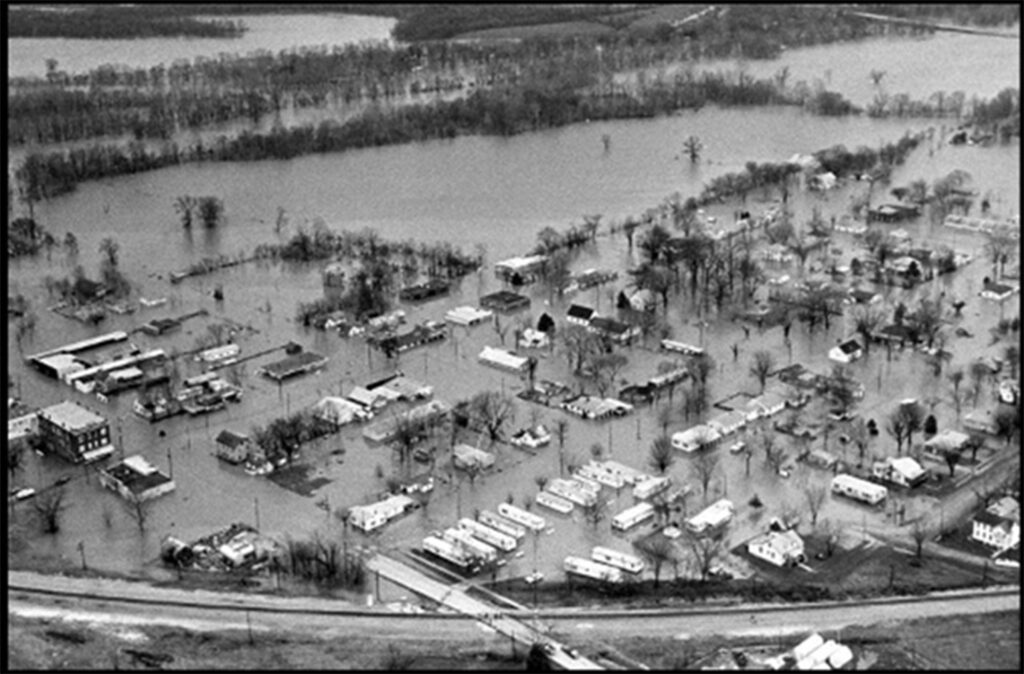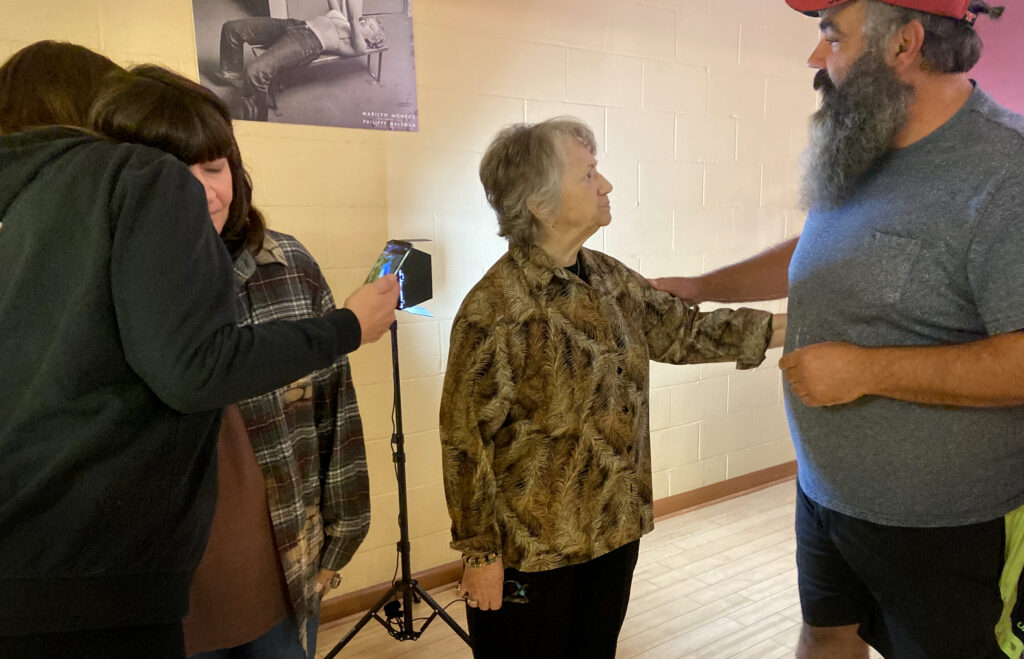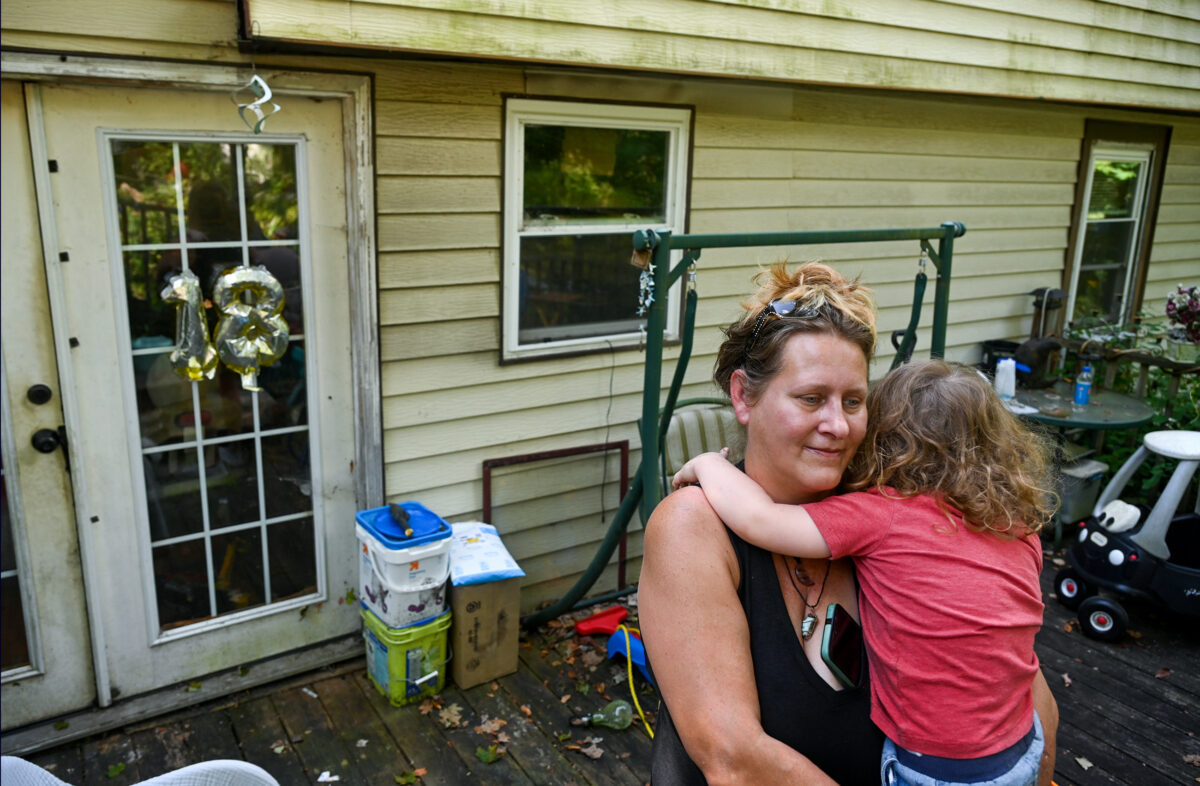One afternoon last week, Christa Graves sat on the back porch of her home just outside of East Palestine, Ohio, and scrolled through pictures on her phone. She was looking for a photo taken 600 miles away, in the heart of the American Midwest.
“It’s in here somewhere,” she said. “I’ve got to figure out my albums.”
Graves’ home is surrounded by trees. A massive maple rises in the center of her backyard. The place seems miles from civilization, but in fact her property rests 1.2 miles from the site of the Feb. 3 toxic train derailment that, at the time, made national news. The burning Norfolk Southern rail cars created a glow that looked like a sunset above the tree line.
After several moments, Graves found the image she was looking for. She held up her phone to show an aerial picture of a well-maintained grass embankment.
“This is what they call the ‘town mound,’” she said. “It’s five football fields long.”
The earthen rise, she explained, stands as a monument to the more than 2,000 people who once lived in the working-class town of Times Beach, Missouri, which was destroyed and buried after one of the worst environmental disasters in the nation’s history.
“Everything they had is now in that mound,” Graves said. “Their homes, their Christmas trees, their toothbrushes, their underwear, their family pictures.”
It’s shocking thought — the entire contents of a town piled into a hole and covered with earth.
“Do you fear that’s the future here in East Palestine?” a visitor asked Graves.
“I fear it’s not,” she said. “I fear they’re going to leave everyone here and wait to deal with the consequences in 10, 20 years.”
• • •
A few days later, East Palestine residents heard the story of Times Beach from someone who’d lived through the disaster — the town’s former mayor, Marilyn Leistner. A small woman of 85, she stood before about 50 people gathered in a large basement room in nearby Darlington, Pennsylvania, and offered a piece of blunt advice to folks concerned they’re living in a place contaminated by chemicals that could ruin their health.
“You people need to be removed from the threat,” she said.

Then Leistner told the Times Beach story.
In the early 1970s, she said, Times Beach hired an oil hauler named Russell Bliss to spray the town’s dirt roads with used motor oil in an effort to suppress dust. It seemed like a good idea. Bliss had been hired to spray oil at a few horse stables for the same reason. No one knew Bliss had mixed his oil with highly toxic dioxin waste he’d been paid to remove from a chemical company.
Problems soon emerged. At the stables, the toxic mix killed dozens of horses. Dead dogs, cats and birds turned up in and around the farms. Children became ill. Residents of Times Beach had no idea their streets were poisoned until 1982, when a reporter called town officials to say he’d seen Times Beach on a list of suspected dioxin sites.
The Environmental Protection Agency began testing the soil. On Dec. 3, 1982, one day after the agency completed its sampling, a historic flood inundated the town.
Two days before Christmas, the EPA recommended residents not return to their Times Beach homes. Officials were concerned the flood waters had spread the dioxin. Most people left with nothing, Leistner said. The EPA declared the town a superfund site and purchased all homes and businesses.
By 1985 Times Beach was a ghost town. The EPA decided everything had to be burned, so an incinerator was built on-site. All evidence that the town was once a vibrant place with a unique history is now ash, buried in the town mound. Even the town’s water tower is gone. Residents tried to save it, but officials said no, burn it and bury it.
“Every once in a while, I’ll miss something,” Leistner said. “Family pictures, my mother’s dishes. It was really hard to lose all of that stuff.”
But it was necessary, she said, because of the health risks. She spoke of neighbors who experienced rashes, headaches, swelling around the eyes, breathing difficulties, nosebleeds, cancers, miscarriages. She recalled a mother who gave birth to two babies suffering from neuroblastoma, a form of cancer diagnosed in only 650 children each year, according to the National Institutes of Health.
One of Leistner’s daughters experienced seizures; another was hospitalized for five weeks for treatment of a thyroid condition.
“I’ve not talked about this publicly, except one time I had to testify in Washington, D.C., about health problems, about my health problems,” she said. “I had excessive periods; they were every other week, every two weeks, and they were horrible. I finally went to a doctor who put me in the hospital and did a complete hysterectomy. He found seven tumors. And I had what they call endometriosis.”
Endometriosis occurs when tissue similar to that in a womb, or uterus, grows in other parts of the body. Symptoms include pain, heavy periods and infertility. Leistner said her daughter developed the disease, too. A study released in 1993 found a connection between dioxin exposure and endometriosis in rhesus monkeys. Other researchers have since questioned this finding, but for Leistner and those in the room, cases of endometriosis in a town exposed to dioxins seem more than coincidental.
Dioxins are created through combustion, and they attach to soil and dust particles. Some experts think the chemical compound may have been released into the atmosphere in East Palestine on Feb. 6, when authorities fearing an explosion vented and then burned off the cancer-causing agent vinyl chloride carried in the damaged rail cars. The fire sent a plume of black smoke billowing out over the town’s placid streets.
Independent test results conducted by Scott Smith, chief sustainability officer for Eco Integrated Technologies, show an alarming increase in dioxin levels in the area. These results differ from findings by the EPA, which subsequently told news organizations that East Palestine’s numbers show normal background levels of dioxin.
Residents such as Graves say the EPA’s numbers don’t jibe with the illnesses and symptoms experienced by residents. Several people expressed skepticism of the agency’s findings.
Leistner said she traveled into East Palestine before the meeting and was appalled to see children walking along sidewalks.
“It’s not safe to be on the street,” she said. “I can’t believe they’re letting that happen.”
One man at the meeting said kids regularly cross the Norfolk Southern railroad tracks and throw rocks into Sulfur Run, near the derailment site, to watch the colorful chemicals that rise to the surface.
Should the town be contaminated, as Smith’s findings show, what are the long-term consequences for residents? Leistner had an answer based on her experience. People in her town were exposed to dioxin for years before realizing they were in danger.
One resident developed breast cancer — a rarity, she said. Upon hearing this, a man in the second row raised his hand. This was Wayne O’Connell of Darlington. He was diagnosed with breast cancer in May, he said. The surgeon who performed a mastectomy told O’Connell he’d treated only five cases of male breast cancer in 30 years of practice.
“I see so much of Times Beach in this room,” Leistner said.
She expressed dismay at the meeting’s attendance. Fifty concerned people from a town of about 4,700 is not nearly enough to make things happen, she said. Leistner urged the crowd to unify all residents in an effort the convince the EPA to buy out the town.
“You’ll have those who are not going to want to be bought out,” she said. “But the more people you have to approach the EPA ….” She paused, then added. “You need to put pressure on people in office today.”
Among those people who need to be pressured, she said, is President Joe Biden. She acknowledged Biden’s recent decision to appoint a disaster recovery coordinator as a small step in the right direction, but East Palestine needs the president to approve a major disaster declaration, which would free up additional federal aid.
And how do residents apply pressure? What’s needed, she said, is publicity.
Leistner told of one successful demonstration conducted in Times Beach. Residents walked along an interstate highway while wearing hazmat clothing on which they’d written messages — “They took out the trash and left the people,” for example, and “Buy us out.” More than 100 people took part, she said.
Creating unity for any such action in East Palestine will be a tough task, said resident Linda Murphy.
“I think our problem is that there’s just too much division in our town, and the division is nasty,” she said. Some residents are angry that their neighbors are speaking out about the dangers. Fear of toxic poisoning has driven some people to move out of town, to spend months living in hotels, while neighbors are going about their lives as if everything is normal.
“You might have one house that’s completely empty and the house next door is putting up Halloween decorations,” Murphy said. “It’s so bizarre and sad that this is what our community has come to.”
Christa Graves expressed a similar sentiment a few days earlier.
“This is a very small community, very intertwined,” Graves said, “so a lot of families are having problems. One family member is saying this place is safe; another is saying it isn’t. They say you’re crazy because you think you’re having symptoms. You’re making it up; you’re psychosomatic. People are afraid of being judged. I know a lot of people who won’t stand up, won’t come out to a protest, because they don’t want to be judged.”
Leistner said Times Beach experienced division, too. In fact, at times tensions were so high she needed a police escort when attending meetings. One angry resident slapped her, she said. People didn’t want to leave everything they’d worked for, “but we had to consider the safety of our children.”
Forty years later, Leistner is the only Times Beach government official who remains to tell the story. All the others have died.
“I’m the only one left,” she said. “For some reason, God is keeping me here, and I think it’s so that I can be here with you today.”

• • •
What would buyouts look like in East Palestine and nearby communities? Christa Graves has thought about this. She bought her house and property in the mid-1990s, when she was 21 years old. She told herself at the time that she was going to stay and fall in love with the place, and she did.
She raised her family here, taking her daughters to the woods and creeks near her home. Before the derailment, she had planned to spend the summer taking her 2-year-old grandson, Asher, to a nearby creek where he could explore the natural world — wade into the water, turn over rocks to look for crayfish and tadpoles. That’s how Graves raised her daughters, with a close connection to the nearby woods, creeks and trails.
Now, Graves won’t take Asher anywhere near those creeks. She worries when he plays on the back porch. What if he puts a leaf in his mouth?
What’s the railroad company’s responsibility for such losses?
“On Feb. 2, if I would have chosen to leave, that would have been on me,” Graves said. “Beginning Feb. 3, that became their burden to bear. They owe us the ability to get what we have here somewhere else. I’m not talking Beverly Hills or New York City or Hollywood. I’m talking about other small communities. I have .66 acres, a two-car garage, a three-bedroom house, a partially wooded lot. I’m five minutes from the grocery. I’m just outside the city limits, and I’m five minutes from clean natural water.”
What would such a property cost elsewhere? Probably more than in East Palestine, which Graves said is a uniquely affordable place to live. Residents who sell their properties at fair market value will have a difficult time affording similar homes in other small towns.
Even if she could sell the place, she’d feel conflicted. Graves thinks she could simply be putting another family in jeopardy.
“Is it morally right to sell?” she asked. “That’s a conundrum for me.”
Like many others, she’s suspicious of EPA reports that the town is safe.
“Those chemicals and gasses and dioxins are still here, floating around in the air, the soil, the water, which soaks into the ground and goes up into the trees, the plants,” she said. “There’s so little coming out from the EPA that lines up with what people have experienced.”
She says she wants to tell the EPA, “You can’t leave my community here to die.”
Steve is a photojournalist and writer for the Pittsburgh Post-Gazette, but he is currently on strike and working as a Union Progress co-editor. Reach him at smellon@unionprogress.com.



